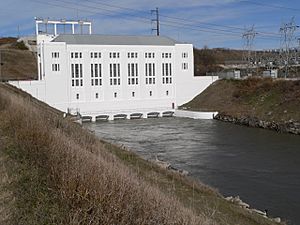Loup Canal facts for kids
The Loup Canal is a special waterway in eastern Nebraska, United States. It helps make electricity from water and also waters farms. A group called Loup Power District owns and runs it.
What is the Loup Canal?
The Loup Canal is a man-made river built for two main jobs. First, it helps create hydroelectric power. This means using the force of moving water to spin turbines and make electricity. Second, it's used for irrigation. This is when water is moved from a river to farm fields to help crops grow.
Where Does the Canal Go?
The canal is about 35 miles (56 kilometers) long. It starts at the Loup River in Nance County, between the towns of Fullerton and Genoa.
As the water flows, it reaches a power plant near Monroe. This plant can make 8,000 kilowatts of electricity. After that, the canal continues to two large storage lakes, Lake Babcock and Lake North. These lakes are just north of Columbus.
From Lake North, the water flows to a second, even bigger power plant near Columbus. This plant can make 40,000 kilowatts of electricity! Finally, the canal ends when its water flows into the Platte River in eastern Platte County.
Building the Canal
Work on the Loup Canal system began in August 1934. It took a few years to build this huge project. The canal started making electricity in March 1937.
Fun Along the Canal
The Loup Canal isn't just for power and farming. There's also a system of parks, lakes, and trails along its path. These places are great for outdoor activities and are also managed by the Loup Power District.


